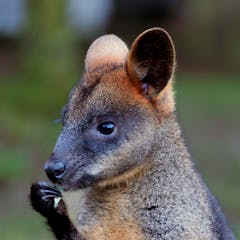
Articles on Marsupials
Displaying 1 - 20 of 69 articles

Australia has already lost so many wonderful mammal species. Do we want the southern greater glider to suffer the same fate?

Each year, hungry plant-eating animals do billions of dollars of damage to valuable plants. We need prevention methods that don’t involve killing them.

Antechinuses are tiny marsupials famous for their intense sex lives. Now, researchers have documented another unusual behaviour – the cannibalism of their own species.

The Marsupial Microbiome Poop Troop collects the droppings of wild marsupials to help save the lives of orphaned joeys.

We found three previously unknown species of mulgaras hiding in museum collections – but all three have been driven to extinction since European colonisation of Australia.

Contributors to the WomSAT website have already reported more than 23,000 wombat sightings. We can use the data to cut the risks to wombats – and anyone with a smartphone can help.

Despite their solitary lifestyle, wombats are at risk from a disease that spreads via their burrows.

The tiny, mouse-like planigales are some of the smallest marsupials around – and there are two more species of them than anybody realised.

From the cuscus with the fancy coat, to the wallaby often sporting a single white glove, a wide variety of life evolved on island homes in the south-west Pacific.

Brain samples of a thylacine that died in 1880 in Berlin were kept safe by researchers for decades. Now, they have finally been analysed.

It’s not as well-known as the Hills Hoist clothesline, but here’s another Aussie invention worth celebrating: Glide poles are reconnecting severed landscapes for a special group of marsupials.

All mammals produce milk. But there’s no milk quite like that produced by monotremes and marsupials. Here’s what’s so special about it.

The ancestors of kangaroos once lived in the trees – but their evolutionary history is murky. Here’s everything we know so far.

Having special foot adaptations helped these sizeable animals wander long distances, which meant a better chance to find plentiful food and water.

Death by exhaustion, cannibalism, complete body fusion: across the animal kingdom, mating takes many strange forms.

Mammals have evolved flight more often than birds. By studying the genes of the sugar glider, biologists have found a ‘molecular toolkit’ for flight membranes that’s been in us all along.

Australia’s Red Centre was once a lush forest filled with strange creatures – and we are slowly discovering more about this enigmatic past.

80,000 years ago, Australia’s landscape was dominated by much larger versions of today’s marsupials – including enigmatic and enormous wombats.

The same technology found in a widely used COVID-19 vaccine could be the key to helping save wild Tassie devils – without any needles.

The teeth of the tammar wallaby don’t grow in the way you’d expect – and scientists want to know why.
